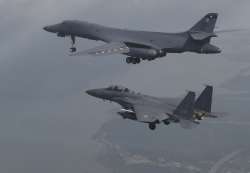Two days after North Korea's latest intercontinental ballistic missile (ICBM) test, the United States flew two supersonic bombers over the Korean Peninsula on Sunday in a show of force against Pyongyang besides carrying out a successful test of a missile interception system located in Alaska. The B-1 bombers were escorted by South Korean fighter jets as they performed a low-pass over an air base near the South Korean capital of Seoul before returning to Andersen Air Force Base in Guam, the U.S. Pacific Air Forces said in a statement. It said the mission was a response to North Korea’s two ICBM tests this month.
Analysts say flight data from the North’s second test, conducted Friday night, showed that a broader part of the mainland United States, including Los Angeles and Chicago, is now in range of Pyongyang’s weapons.
“North Korea remains the most urgent threat to regional stability,” said Gen. Terrence J. O’Shaughnessy, Pacific Air Forces commander. “Diplomacy remains the lead. However, we have a responsibility to our allies and our nation to showcase our unwavering commitment while planning for the worst-case scenario.”
“If called upon, we are ready to respond with rapid, lethal, and overwhelming force at a time and place of our choosing,” O’Shaughnessy said.
The United States often sends powerful warplanes in times of heightened tensions with North Korea. B-1 bombers have been sent to South Korea for flyovers several times this year in response to the North’s banned missile tests, and also following the death of a U.S. college student last month after he was released by North Korea in a coma.
The Hwasong-14 ICBM, which the North first tested on July 4, is the highlight of several new weapons systems Pyongyang launched this year. They include an intermediate range missile that North Korea says is capable of hitting Alaska and Hawaii, and a solid-fuel midrange missile, which analysts say can be fired faster and more secretly than liquid-fuel missiles.
US successfully tests missile intercept system
The US Missile Defense Agency said a Terminal High Altitude Area Defense, or THAAD, system located in Kodiak, Alaska, was successfully tested on Saturday night. It said that a medium-range ballistic missile was air-launched from a US Air Force C-17 aircraft flying over the Pacific and a THAAD unit in Alaska "detected, tracked and intercepted the target."
The US Missile Defense Agency said this was the 15th successful intercept in 15 tests for the THAAD.
Parts of the THAAD defense system were brought into South Korea under the government of ousted president Park Geun-Hye. But new leader Moon Jae-In suspended deployment of the programme last month, citing the need for a new environmental impact assessment.
However, Seoul said on Saturday that it will speed up deployment of a THAAD battery on its territory because of the latest North Korean test of an intercontinental ballistic missile. South Korean Defense Minister Song Young-Moo said yesterday that Seoul will now begin consultations on the "tentative deployment" parts of the THAAD battery in response to the latest North Korean test.
The THAAD deployment has infuriated China, which has long argued it will destabilise the region.
(With AP inputs)
Latest World News
